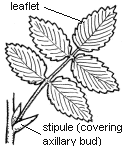"Of course, that’s
the 'leaf-shaped' thing on the maple tree"
We all know what a leaf
is. And we know they come in a variety of shapes, sizes,
and colors. Let’s start off by thinking about the role
of leaves.
A leaf’s primary purpose
is to capture light, which is the energy source the plant uses
to manufacture its food. Most plants hold their leaves in positions
that maximize exposure to the sun.
Though there are many variations,
most leaves are composed of a thin sheet-like blade attached
to the stem with a leaf stalk, or petiole
(PEH-tee-ole; La. petiolus=stalk). At the base of the
petiole (where it attaches to the stem) is the axillary
bud. On some plants the axillary bud is covered by a structure
called the stipule.
The diagrams below represent a typical simple leaf and compound
leaf.
Leaf
Parts
Simple leaf
Leaf
Parts
Compound Leaf

Different plants' leaves vary
in:
-
their ability to shed or conserve water
- how much surface area they
expose to sunlight
- how much sunlight they allow
to pass through to lower leaves
- weight--and how strong a petiole
they require
- how much battering by wind
and rain they can tolerate before they disintegrate.
Climate, location, and competition from other plants all affect
a leaf's ability to do its job--capture light. For example,
plants growing in shaded environments often have relatively
large leaves to maximize the surface area exposed to the limited
sunlight. On the other hand, the grasses in open prairies get
plenty of sunlight, but they must contend with winds that can
blow plants over and break their stems. A grass plant's tall,
narrow leaves are less likely to be torn by the wind than are
broad, sail-like leaves.
Of course there are no hard-and-fast rules, and there are plenty
of small-leaved, shade-loving plants!

|
|
| NOTE: Since
botany, like so many sciences, uses words drawn from Latin (La.) and Greek (Gr.),
we’ll give word origins to make the terms easier to understand and remember.
We’ll also provide a pronunciation key for difficult terms. |
 Looking at Leaves
Which plants in your
garden or home have:
� waxy leaves to conserve moisture? (ex. hoya, jade plant)
� succulent leaves that store water? (ex. aloe, kalanchoe)
� delicate leaves that allow sunlight to filter through?
(ex. locust, maidenhair fern)
� large, heavy leaves attached with a sturdy stalk? (ex.
canna, rubber plant)
� lightweight leaves that flutter in the breeze? (ex.
aspen, willow)
Knowing a plant’s
leaf characteristics can sometimes give you a clue about its care. For example, plants
with thick, fleshy leaves or waxy coatings are often native to arid climates where these
characteristics help them conserve water. These plants should be watered sparingly,
because overwatering can quickly lead to root rot. |
|
|